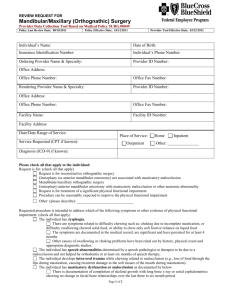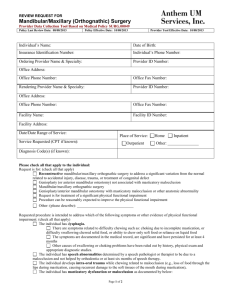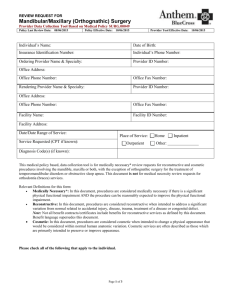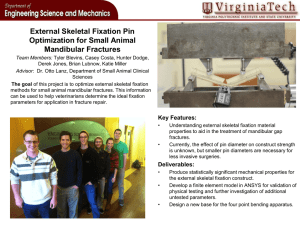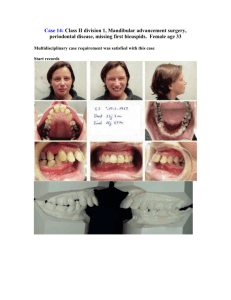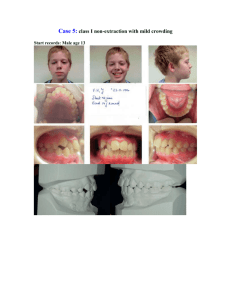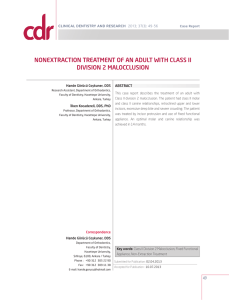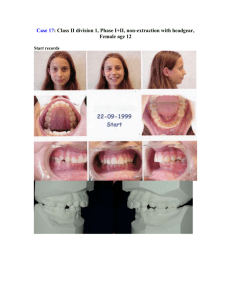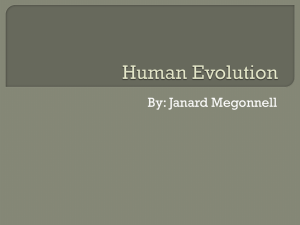Longitudinal growth changes in untreated subjects with Class II
advertisement
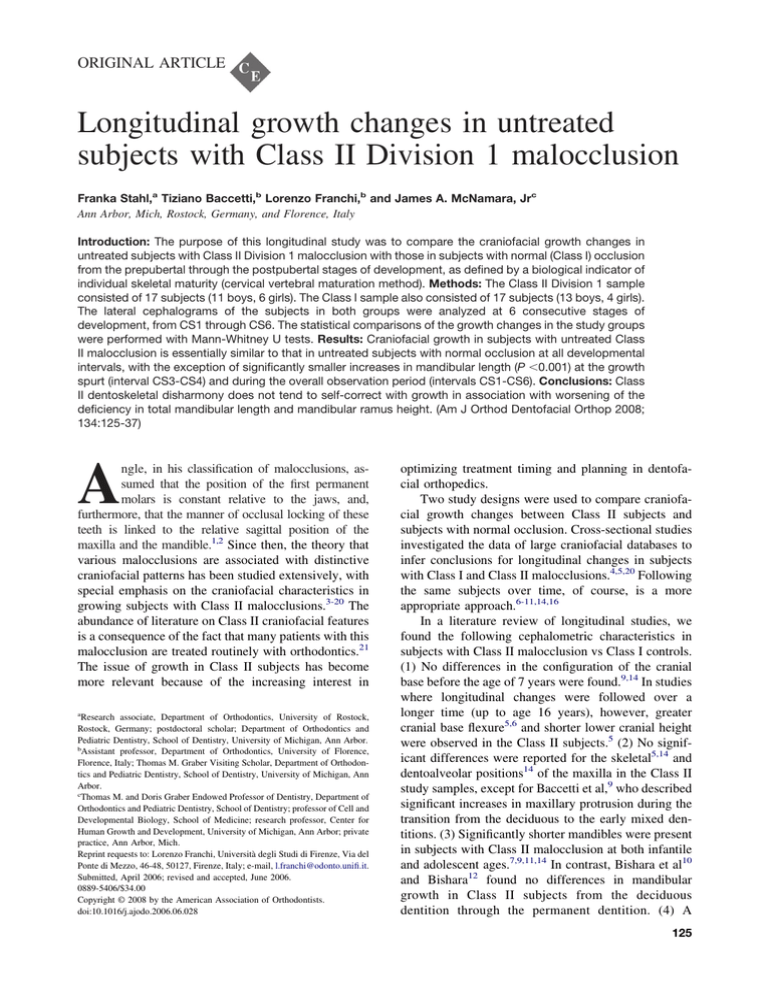
ORIGINAL ARTICLE Longitudinal growth changes in untreated subjects with Class II Division 1 malocclusion Franka Stahl,a Tiziano Baccetti,b Lorenzo Franchi,b and James A. McNamara, Jrc Ann Arbor, Mich, Rostock, Germany, and Florence, Italy Introduction: The purpose of this longitudinal study was to compare the craniofacial growth changes in untreated subjects with Class II Division 1 malocclusion with those in subjects with normal (Class I) occlusion from the prepubertal through the postpubertal stages of development, as defined by a biological indicator of individual skeletal maturity (cervical vertebral maturation method). Methods: The Class II Division 1 sample consisted of 17 subjects (11 boys, 6 girls). The Class I sample also consisted of 17 subjects (13 boys, 4 girls). The lateral cephalograms of the subjects in both groups were analyzed at 6 consecutive stages of development, from CS1 through CS6. The statistical comparisons of the growth changes in the study groups were performed with Mann-Whitney U tests. Results: Craniofacial growth in subjects with untreated Class II malocclusion is essentially similar to that in untreated subjects with normal occlusion at all developmental intervals, with the exception of significantly smaller increases in mandibular length (P ⬍0.001) at the growth spurt (interval CS3-CS4) and during the overall observation period (intervals CS1-CS6). Conclusions: Class II dentoskeletal disharmony does not tend to self-correct with growth in association with worsening of the deficiency in total mandibular length and mandibular ramus height. (Am J Orthod Dentofacial Orthop 2008; 134:125-37) A ngle, in his classification of malocclusions, assumed that the position of the first permanent molars is constant relative to the jaws, and, furthermore, that the manner of occlusal locking of these teeth is linked to the relative sagittal position of the maxilla and the mandible.1,2 Since then, the theory that various malocclusions are associated with distinctive craniofacial patterns has been studied extensively, with special emphasis on the craniofacial characteristics in growing subjects with Class II malocclusions.3-20 The abundance of literature on Class II craniofacial features is a consequence of the fact that many patients with this malocclusion are treated routinely with orthodontics.21 The issue of growth in Class II subjects has become more relevant because of the increasing interest in a Research associate, Department of Orthodontics, University of Rostock, Rostock, Germany; postdoctoral scholar; Department of Orthodontics and Pediatric Dentistry, School of Dentistry, University of Michigan, Ann Arbor. b Assistant professor, Department of Orthodontics, University of Florence, Florence, Italy; Thomas M. Graber Visiting Scholar, Department of Orthodontics and Pediatric Dentistry, School of Dentistry, University of Michigan, Ann Arbor. c Thomas M. and Doris Graber Endowed Professor of Dentistry, Department of Orthodontics and Pediatric Dentistry, School of Dentistry; professor of Cell and Developmental Biology, School of Medicine; research professor, Center for Human Growth and Development, University of Michigan, Ann Arbor; private practice, Ann Arbor, Mich. Reprint requests to: Lorenzo Franchi, Università degli Studi di Firenze, Via del Ponte di Mezzo, 46-48, 50127, Firenze, Italy; e-mail, l.franchi@odonto.unifi.it. Submitted, April 2006; revised and accepted, June 2006. 0889-5406/$34.00 Copyright © 2008 by the American Association of Orthodontists. doi:10.1016/j.ajodo.2006.06.028 optimizing treatment timing and planning in dentofacial orthopedics. Two study designs were used to compare craniofacial growth changes between Class II subjects and subjects with normal occlusion. Cross-sectional studies investigated the data of large craniofacial databases to infer conclusions for longitudinal changes in subjects with Class I and Class II malocclusions.4,5,20 Following the same subjects over time, of course, is a more appropriate approach.6-11,14,16 In a literature review of longitudinal studies, we found the following cephalometric characteristics in subjects with Class II malocclusion vs Class I controls. (1) No differences in the configuration of the cranial base before the age of 7 years were found.9,14 In studies where longitudinal changes were followed over a longer time (up to age 16 years), however, greater cranial base flexure5,6 and shorter lower cranial height were observed in the Class II subjects.5 (2) No significant differences were reported for the skeletal5,14 and dentoalveolar positions14 of the maxilla in the Class II study samples, except for Baccetti et al,9 who described significant increases in maxillary protrusion during the transition from the deciduous to the early mixed dentitions. (3) Significantly shorter mandibles were present in subjects with Class II malocclusion at both infantile and adolescent ages.7,9,11,14 In contrast, Bishara et al10 and Bishara12 found no differences in mandibular growth in Class II subjects from the deciduous dentition through the permanent dentition. (4) A 125 126 Stahl et al retruded position of the mandible was described in growing patients with Class II malocclusion.5,7,9,14 (5) The differences in craniofacial measures were found to be established early in life, and the growth trends in Class II and Class I subjects appeared to be essentially similar thereafter.8-10,12 The review of the literature, therefore, showed no consensus, especially with regard to the growth changes of the mandible in untreated subjects with Class II malocclusion when compared with subjects with normal occlusion. However, the results in most of these studies were based on longitudinal growth changes related to the subjects’ chronologic ages or the dentition stages. The analysis of modifications in growth benefits greatly from considering the individual skeletal maturity of the subjects.22 Neither chronologic age nor dentition stage is a reliable indicator of skeletal maturation.23-27 The aim of this study was to compare longitudinal craniofacial growth changes in untreated subjects with Class II malocclusion with those in subjects with normal occlusion from the prepubertal through the postpubertal stages of development, as defined by a biologic indicator of individual skeletal maturity (cervical vertebral maturation method).28 MATERIAL AND METHODS The files of the University of Michigan Growth Study (UMGS, n ⫽ 706) and the Denver Growth Study (DGS, n ⫽ 155) were searched for longitudinal records of orthodontically untreated subjects with either Class II or Class I malocclusion. Lateral cephalograms of good quality at 6 consecutive developmental intervals (T1 through T6) corresponding to the 6 stages in cervical vertebral maturation (CS1-CS6) had to be available for all subjects.28 The first 2 stages (CS1 and CS2) occur before the pubertal growth peak. The peak in skeletal growth is between CS3 and CS4. Deceleration in craniofacial growth occurs during the postpubertal intervals, from CS4 through CS6. Longitudinal records for all subjects, therefore, covered the entire circumpubertal period from the prepubertal through the postpubertal stages of skeletal development. All subjects were white and had no craniofacial abnormalities or tooth anomalies in number or eruption (supernumeraries, congenitally missing teeth, impacted canines). Subjects with Class II Division 1 malocclusion were diagnosed according to the following signs at T1: full-cusp or half-cusp Class II molar relationship, excessive overjet (⬎4 mm) and ANB angle greater than 3°. After the eruption of the permanent dentition, all subjects with a half-cusp Class II molar relationship developed a full-cusp Class II molar relationship. Sub- American Journal of Orthodontics and Dentofacial Orthopedics July 2008 Table I. Descriptive statistics for age (y) at the 6 consecutive cervical vertebral maturation stages Class II subjects (n ⫽ 17) CS1 CS2 CS3 CS4 CS5 CS6 Class I subjects (n ⫽ 17) Mean SD Mean SD 10.2 11.1 12.1 13.2 14.3 15.4 1.3 1.4 1.3 1.4 1.4 1.5 10.1 11.1 12.2 13.3 14.5 15.7 1.2 1.2 1.2 1.3 1.5 1.6 jects with Class I occlusion were selected according to the Class I molar relationship at T1, with normal overjet (2-4 mm) and ANB angle between 0° and 3°. All subjects in both groups had normal vertical relationships at T1 (Frankfort horizontal to mandibular plane, 23.6° ⫾ 5.1° and 23.4° ⫾ 4.0° in the Class II and Class I samples, respectively). The Class II Division 1 sample consisted of 17 subjects (11 boys, 6 girls). The Class I sample also included 17 subjects (13 boys, 4 girls). Their mean ages at the 6 stages of cervical vertebral maturation are reported in Table I. Cephalograms were traced by 1 investigator (F.S.) and verified for landmark location, anatomical contours, and tracing superimpositions by another (J.A.Mc.). Any disagreements were resolved by retracing the landmark or structure to the satisfaction of both observers. A customized digitization regimen and analysis from Dentofacial Planner (Dentofacial Software, Toronto, Ontario, Canada) was used for all cephalograms examined in this study. The cephalometric analysis required the digitization of 77 landmarks and 4 fiducial markers. The customized cephalometric analysis— containing measurements from the analyses of Steiner,29 Jacobson,30 Ricketts,31 and McNamara32— generated 33 variables (11 angular, 22 linear) for each tracing. All sets of cephalograms were traced at the same time. A preliminary tracing was made for each film in the series, with particular attention paid to tracing the outlines of the maxilla and the mandible, including the mandibular condyle. Then each set of consecutive films was checked thoroughly, beginning with the second and third films in the series. Fiducial markers were placed in the maxilla and the mandible on the third tracing and then transferred to the second tracings in each subject’s cephalometric series, based on superimposition of internal maxillary or mandibular structures. The locations of the fiducial markers then were trans- American Journal of Orthodontics and Dentofacial Orthopedics Volume 134, Number 1 ferred to the first and then the fourth through the sixth films similarly. The maxillae were superimposed along the palatal plane by registering on the bony internal details superior to the incisors, and the superior and inferior surfaces of the hard palate. Fiducial markers were placed in the anterior and posterior parts of the maxilla along the palatal plane. This superimposition describes the movement of the maxillary dentition. The mandibles were superimposed posteriorly on the outline of the mandibular canal. Anteriorly, they were superimposed on the anterior contour of the chin and the bony structures of the symphysis.31,32 A fiducial marker was placed in the center of the symphysis and another in the body of the mandible near the gonial angle. This superimposition facilitated measuring the movement of the mandibular dentition. The magnifications of the 2 data sets were different, with the lateral cephalograms from the UMGS at 12.9% and those from the DGS at 4%. Therefore, the lateral cephalograms from the 2 studies were corrected to an 8% enlargement factor. A total of 42 lateral cephalograms randomly chosen from all observations were retraced and redigitized to calculate the method error with Dahlberg’s formula.33 The error for linear measurements ranged from 0.2 (overjet) to 0.8 mm (pogonion to nasion perpendicular); the error for the angular measurements varied from 0.4° (ANB angle) to 1.6° (interincisal angle). The stages in cervical vertebral maturation on the lateral cephalograms for each subject were assessed by 1 investigator (T.B.) and verified by another (L.F.).28 Any disagreements were resolved to the satisfaction of both observers. Statistical analysis Descriptive statistics of craniofacial measurements in both Class II and Class I samples at T1 through T6 were calculated, as well as the between-stage changes. The Kolmogorov-Smirnov test showed lack of normal distribution for several measurements. Therefore, nonparametric statistics with Mann-Whitney U tests were used. The following comparisons were made: (1) starting forms between Class II and Class I samples at T1, (2) final forms between Class II and Class I samples at T6, (3) between-stage changes (T2-T1, T3-T2, T4-T3, T5-T4, T6-T5) in Class II vs Class I samples, and (4) overall changes (T6-T1) between the Class II and Class I samples. RESULTS Descriptive statistics for the cephalometric measurements in the Class II and Class I subjects at T1 and Stahl et al 127 T6 are given in Tables II and III. Results of the statistical comparison between the Class II and Class I subjects of the changes in all cephalometric variables at the growth intervals, as well as the statistical comparisons of the overall changes are shown in Tables IV through IX. In the comparison of the T1 forms between the Class II and Class I samples (Table II), the measurement of cranial base flexure was significantly greater in subjects with Class II malocclusion at the beginning of the observation period. There were no statistically significant differences between the 2 groups with regard to maxillary skeletal and dentoalveolar measures. No significant differences were found for mandibular dimensions. The mandible was significantly retruded in the Class II subjects when related to the anterior cranial base. This difference was also reflected by the significantly greater intermaxillary sagittal discrepancy (Wits appraisal, maxillomandibular differential, and ANB angle) in the Class II sample. No significant differences were found for vertical skeletal relationships. As expected on the basis of the inclusion criteria, overjet was significantly greater and the molar relationship was significantly smaller in the Class II subjects. The mandibular incisors were significantly retruded in the Class II sample when compared with the Class I sample. In the comparison of T6 forms between the Class II and Class I samples (Table III), no significant difference was found between the flexure of the cranial base in the Class II and Class I samples at the end of the observation period. All differences that were statistically significant at T1 were so at T6 with 2 significant differences: total mandibular length (Co-Gn) was significantly shorter at the end of the observation period in the Class II sample than in the Class I sample; the maxillary incisors were more protruded in the Class II sample at T6. In the comparison of between-stage changes (T2T1, T3-T2, T4-T3, T5-T4, T6-T5) in the Class II vs Class I samples (Tables IV-VIII), no significant differences were found for the changes between T1 and T2. In the transition from T2 to T3, a significant difference in the maxillomandibular differential was found in the Class II group. A significantly smaller decrease in the gonial angle (ArGoMe) was observed in the Class II subjects than in the Class I subjects (⫹1.2°). Between T3 and T4, corresponding to the pubertal growth spurt, a significantly smaller increase in total mandibular length (Co-Gn) became apparent in the Class II group (⫺2.0 mm).28 A significant buccal inclination of the mandibular incisors to the mandibular plane was also found in the Class II group (⫹1.4°). No significant 128 Stahl et al American Journal of Orthodontics and Dentofacial Orthopedics July 2008 Table II. Descriptive statistics and statistical comparisons for cephalometric measurements in Class II and Class I subjects at T1 (CS1) Class II n ⫽ 17 Cephalometric measure Cranial base NSBa (°) Maxillary skeletal Co-Pt A (mm) SNA (°) Pt A to nasion perp (mm) Mandibular skeletal Co-Gn (mm) Co-Go (mm) SNB (°) Pg to nasion perp (mm) Maxillary/mandibular Wits (mm) Max/mand diff (mm) ANB (°) Vertical skeletal FH to palatal plane (°) FH to mandibular plane (°) ArGoMe (°) CoGoMe (°) N to ANS (mm) ANS to Me (mm) Interdental Overbite (mm) Overjet (mm) Interincisal angle (°) Molar relationship (mm) Maxillary dentoalveolar U1 to Pt A vertical (mm) U1 to FH (°) Mandibular dentoalveolar L1 to Pt A-pogonion (mm) L1 to mandibular plane (°) Class I n ⫽ 17 Mean SD Mean SD Difference Significance 133.3 3.6 129.9 4.1 ⫹3.4 * 84.8 79.5 ⫺0.9 5.3 2.8 2.9 85.4 80.3 ⫺1.2 4.4 2.2 2.2 ⫺0.6 ⫺0.8 ⫹0.3 NS NS NS 106.3 52.5 74.7 ⫺9.2 6.5 5.0 2.2 5.1 109.0 53.4 78.1 ⫺6.0 6.5 3.9 2.8 4.8 ⫺2.7 ⫺0.9 ⫺3.4 ⫺3.2 NS NS 3.3 21.1 4.9 2.2 3.5 1.8 ⫺0.9 24.5 2.2 2.7 4.2 2.1 ⫹4.2 ⫺3.4 ⫹2.7 * 2.5 23.6 122.0 122.4 49.8 62.2 3.7 5.1 7.6 6.1 3.2 5.1 2.0 23.4 123.6 124.2 49.2 62.7 2.5 4.0 5.4 4.5 3.1 4.6 ⫹0.5 ⫹0.2 ⫺1.6 ⫺1.8 ⫹0.6 ⫺0.5 NS NS NS NS NS NS 4.2 6.4 130.4 ⫺1.9 1.8 1.8 10.8 1.2 3.3 3.9 129.1 0.8 1.8 1.1 8.6 1.0 ⫹0.9 ⫹2.5 ⫹1.3 ⫺2.7 NS 4.6 110.2 1.7 6.8 5.4 111.4 2.3 8.6 ⫺0.8 ⫺1.2 NS NS 1.2 95.8 1.7 6.4 3.3 93.9 1.7 6.9 ⫺2.1 ⫹1.9 NS † NS ‡ † ‡ NS ‡ † NS, Not significant; *P ⬍0.05; †P ⬍0.01; ‡P ⬍0.001. differences were found for the changes between T4 and T5 and between T5 and T6 in the 2 groups. In the comparison of overall changes (T6-T1) between the Class II and Class I samples (Table IX), the total changes (CS1-CS6) showed a significantly smaller increase in total mandibular length (Co-Gn, ⫺2.9 mm) and height of the mandibular ramus (Co-Go, ⫺1.5 mm) in the Class II subjects. The growth deficiency in mandibular length was associated with a significantly smaller increase in the maxillomandibular differential (⫺1.7 mm) in the Class II group. DISCUSSION Class II malocclusion is a commonly observed clinical problem, occurring in about a quarter to a third of the United States population.34-37 According to data from a federally funded study of the population (Third National Health and Nutrition Examination Survey, or NHANES III38,39), about 15% have overjets greater than 4 mm. Because Class II malocclusion is recognized easily by health professionals and by patients and their families, especially in instances of excessive overjet, the correction of Class II problems might be nearly half of the treatment protocols in a typical orthodontic practice.21 Despite the substantial prevalence of Class II Division 1 malocclusion as an orthodontic problem, few studies have analyzed the growth trends of subjects with distal molar relationship and excessive overjet. This information is vital in terms of growth expectations of patients observed at an early developmental Stahl et al 129 American Journal of Orthodontics and Dentofacial Orthopedics Volume 134, Number 1 Table III. Descriptive statistics and statistical comparisons for cephalometric measurements in Class II and Class I subjects at T6 (CS6) Class II n ⫽ 17 Cephalometric measure Cranial base NSBa (°) Maxillary skeletal Co-Pt A (mm) SNA (°) Pt A to nasion perp (mm) Mandibular skeletal Co-Gn (mm) Co-Go (mm) SNB (°) Pg to nasion perp (mm) Maxillary/mandibular Wits (mm) Max/mand diff (mm) ANB (°) Vertical skeletal FH to palatal plane (°) FH to mandibular plane (°) ArGoMe (°) CoGoMe (°) N to ANS (mm) ANS to Me (mm) Interdental Overbite (mm) Overjet (mm) Interincisal angle (°) Molar relationship (mm) Maxillary dentoalveolar U1 to Pt A vertical (mm) U1 to FH (°) Mandibular dentoalveolar L1 to Pt A-pogonion (mm) L1 to mandibular plane (°) Class I n ⫽ 17 Mean SD Mean SD Difference Significance 133.4 4.1 131.3 3.5 ⫹2.1 NS 93.3 79.9 ⫺0.5 5.7 3.4 3.2 94.6 80.7 ⫺0.5 4.4 2.6 3.2 ⫺1.3 ⫺0.8 0.0 NS NS NS 119.7 61.6 75.9 ⫺6.2 7.9 6.4 3.0 7.0 126.3 64.7 79.8 ⫺0.9 6.5 3.8 3.0 7.0 ⫺6.6 ⫺3.1 ⫺3.9 ⫺5.3 4.1 26.8 4.0 2.4 4.9 1.7 ⫺0.9 32.1 0.9 3.1 5.6 2.6 ⫹5.0 ⫺5.3 ⫹3.1 ‡ 1.3 22.0 119.3 120.9 56.5 67.7 4.6 5.5 7.8 6.1 3.6 6.4 1.3 20.1 120.4 122.5 55.6 69.2 2.9 4.2 6.5 5.1 3.3 6.0 0.0 ⫹1.9 ⫺1.1 ⫺1.6 ⫹0.9 ⫺1.5 NS NS NS NS NS NS 4.5 5.9 133.3 ⫺1.1 1.9 1.8 12.3 1.3 3.3 3.7 134.3 1.6 1.6 1.4 8.5 1.6 ⫹1.2 ⫹2.2 ⫺1.0 ⫺2.7 NS 5.2 109.6 2.3 9.0 7.0 113.5 1.9 5.5 ⫺1.8 ⫺3.9 * NS 1.3 95.1 2.5 8.0 3.2 92.2 1.7 6.0 ⫺1.9 2.9 * NS † NS † * † ‡ ‡ NS ‡ NS, Not significant; *P ⬍0.05; †P ⬍0.01; ‡P ⬍0.001. phase for treatment planning and timing, and for the evaluation of treatment outcomes in growing patients. Only 3 major longitudinal studies have described the growth changes in the dentofacial region of orthodontically untreated Class II subjects compared with untreated samples with normal occlusion.7,10,11 Bishara et al10 observed the growth trends in Class II malocclusion from the deciduous through the permanent dentitions with an average starting age of 5 years and an average final age of 12.2 years. They did not report significant differences between the Class II and Class I samples (except for upper lip protrusion). Several characteristics of that investigation should be considered when evaluating their outcomes.10 As they stated, the most severe cases were excluded from the group with Class II malocclusion. Furthermore, the analysis of growth trends ended at an average age of 12.2 years when active growth is not completed. On the other hand, both Kerr and Hirst7 and Ngan et al11 found significant differences in growth changes between Class II and Class I subjects. In particular, Kerr and Hirst7 found a deficiency in mandibular growth (measured by means of Ar-Pg) in Class II subjects from 5 through 15 years of age, with the greatest difference between 10 and 15 years (about 2 mm). Ngan et al11 described a much greater deficiency in mandibular growth in Class II vs Class I subjects: 9.6 mm from 7 through 14 years of age. None of these 3 longitudinal studies used a biologic indicator of individual skeletal maturity to determine the developmental status of their Class II and Class I subjects. Our aim in this study was to analyze the longitudi- 130 Stahl et al Table IV. American Journal of Orthodontics and Dentofacial Orthopedics July 2008 Changes between T1 and T2 (CS1 and CS2) in Class II and Class I subjects and statistical comparisons Class II n ⫽ 17 Cephalometric measure Cranial base NSBa (°) Maxillary skeletal Co-Pt A (mm) SNA (°) Pt A to nasion perp (mm) Mandibular skeletal Co-Gn (mm) Co-Go (mm) SNB (°) Pg to nasion perp (mm) Maxillary/mandibular Wits (mm) Max/mand diff (mm) ANB (°) Vertical skeletal FH to palatal plane (°) FH to mandibular plane (°) ArGoMe (°) CoGoMe (°) N to ANS (mm) ANS to Me (mm) Interdental Overbite (mm) Overjet (mm) Interincisal angle (°) Molar relationship (mm) Maxillary dentoalveolar U1 to Pt A vertical (mm) U1 to FH (°) U1 horizontal (mm) U1 vertical (mm) U6 horizontal (mm) U6 vertical (mm) Mandibular dentoalveolar L1 to Pt A-pogonion (mm) L1 to mandibular plane (°) L1 horizontal (mm) L1 vertical (mm) L6 horizontal (mm) L6 vertical (mm) Class I n ⫽ 17 Mean SD Mean SD Difference Significance 0.0 1.5 0.4 1.4 ⫺0.4 NS 1.7 0.3 0.2 1.0 0.9 0.6 2.1 0.4 0.3 1.3 1.1 0.8 ⫺0.3 ⫺0.1 ⫺0.1 NS NS NS 2.7 1.2 0.3 0.6 1.2 0.8 1.0 1.3 3.0 1.7 0.2 0.5 1.3 1.4 0.9 1.1 ⫺0.3 ⫺0.5 ⫹0.1 ⫹0.1 NS NS NS NS 0.2 0.9 ⫺0.1 1.3 1.0 0.7 0.3 0.4 0.2 1.4 1.0 0.7 ⫺0.1 ⫹0.5 ⫺0.3 NS NS NS ⫺0.4 ⫺0.1 ⫺0.8 ⫺0.4 1.8 0.9 0.81 0.8 1.2 1.0 1.0 1.0 ⫺0.4 ⫺0.5 0.0 ⫺0.1 1.7 0.8 1.1 0.7 1.6 1.3 0.8 0.9 0.0 ⫹0.4 ⫺0.8 ⫺0.3 ⫹0.1 ⫹0.1 NS NS NS NS NS NS 0.6 ⫺0.2 1.4 0.1 0.9 1.0 3.2 0.5 0.5 0.2 2.0 0.2 1.1 0.8 3.3 0.5 ⫹0.1 ⫺0.4 ⫺0.6 ⫺0.1 NS NS NS NS 0.0 ⫺1.1 0.3 0.3 0.6 0.8 0.4 2.4 0.5 0.8 0.8 0.6 0.1 0.6 0.4 0.1 0.2 0.4 1.1 6.6 1.1 1.2 0.6 0.8 ⫺0.1 ⫺1.7 ⫺0.1 ⫹0.2 ⫹0.4 ⫹0.3 NS NS NS NS NS NS 0.0 ⫺0.3 0.1 0.8 0.3 0.2 0.6 1.7 0.5 0.6 0.5 0.6 ⫺0.2 ⫺0.2 0.2 0.6 0.4 0.6 0.7 2.8 0.6 0.7 0.5 0.7 ⫹0.2 ⫺0.1 ⫺0.1 0.2 ⫺0.1 ⫺0.4 NS NS NS NS NS NS NS, Not significant. nal craniofacial growth changes in untreated subjects with Class II malocclusion with those in subjects with normal occlusion from the prepubertal through the postpubertal stages with the cervical vertebral maturation method.28 This method is reliable for detecting a subject’s skeletal maturity and for identifying the pubertal growth spurt in the mandible. The 6 stages of cervical vertebral maturation cover the entire circumpubertal period, and these stages indicate the times of accelerated, maximum, and decelerated mandibular growth. The peak in mandibular growth occurs between CS3 and CS4 in both sexes.28 At the beginning of the observation period (CS1), the Class II subjects were characterized by an obtuse cranial base angle, a retruded mandible, an excessive value for the Wits appraisal, and retroclined mandibular incisors, in addition to the occlusal features of Class II Division 1 malocclusion (excessive overjet and distal molar relationship). These results are consistent with those of previous studies, and they show that dentoskel- Stahl et al 131 American Journal of Orthodontics and Dentofacial Orthopedics Volume 134, Number 1 Table V. Changes between T2 and T3 (CS2 and CS3) in Class II and Class I subjects and statistical comparisons Class II n ⫽ 17 Cephalometric measure Cranial base NSBa (°) Maxillary skeletal Co-Pt A (mm) SNA (°) Pt A to nasion perp (mm) Mandibular skeletal Co-Gn (mm) Co-Go (mm) SNB (°) Pg to nasion perp (mm) Maxillary/mandibular Wits (mm) Max/mand diff (mm) ANB (°) Vertical skeletal FH to palatal plane (°) FH to mandibular plane (°) ArGoMe (°) CoGoMe (°) N to ANS (mm) ANS to Me (mm) Interdental Overbite (mm) Overjet (mm) Interincisal angle (°) Molar relationship (mm) Maxillary dentoalveolar U1 to Pt A vertical (mm) U1 to FH (°) U1 horizontal (mm) U1 vertical (mm) U6 horizontal (mm) U6 vertical (mm) Mandibular dentoalveolar L1 to Pt A-pogonion (mm) L1 to mandibular plane (°) L1 horizontal (mm) L1 vertical (mm) L6 horizontal (mm) L6 vertical (mm) Class I n ⫽ 17 Mean SD Mean SD Difference Significance 0.0 1.3 0.0 1.2 0.0 NS 1.6 ⫺0.1 ⫺0.1 0.9 0.9 0.6 1.0 ⫺0.2 ⫺0.2 1.0 1.1 1.0 ⫹0.6 ⫹0.1 ⫹0.1 NS NS NS 2.5 1.4 0.1 0.3 1.1 1.2 0.7 1.0 2.6 1.4 0.2 0.6 0.9 0.9 0.7 0.9 ⫺0.1 0.0 ⫺0.1 ⫺0.3 NS NS NS NS 0.1 1.0 ⫺0.2 0.7 0.8 0.4 ⫺0.2 1.6 ⫺0.3 1.0 0.9 0.8 ⫹0.3 ⫺0.6 ⫹0.1 NS * NS ⫺0.2 ⫺0.2 ⫺0.1 0.1 1.4 0.9 1.0 0.9 1.1 1.0 0.9 0.9 0.1 ⫺0.4 ⫺1.3 ⫺0.4 1.1 1.4 0.8 1.0 1.3 0.9 0.7 0.8 ⫺0.3 ⫹0.2 ⫹1.2 ⫹0.5 ⫹0.3 ⫺0.5 NS NS * NS NS NS 0.2 0.2 0.1 0.3 0.6 0.5 2.5 0.6 0.0 ⫺0.1 0.0 0.3 0.9 0.5 4.2 0.8 ⫹0.2 ⫹0.3 ⫹0.1 0.0 NS NS NS NS 0.3 0.4 0.5 0.4 0.5 0.5 0.7 2.2 0.7 0.6 0.7 0.7 0.4 ⫺0.5 0.6 0.8 0.9 1.0 0.7 2.4 0.6 0.7 0.8 0.7 ⫺0.1 ⫹0.9 ⫺0.1 ⫺0.4 ⫺0.4 ⫺0.5 NS NS NS NS NS NS 0.0 ⫺0.3 0.0 0.6 0.8 0.9 0.6 2.0 0.6 0.7 0.7 0.7 0.2 0.9 0.2 0.6 0.6 0.9 0.6 2.8 0.6 0.4 0.6 0.5 ⫺0.2 ⫺1.2 ⫺0.2 0.0 ⫹0.2 0.0 NS NS NS NS NS NS NS, Not significant; *P ⬍0.05. etal characteristics of Class II malocclusion are established early in development.5,7,9,14 There were no significant differences in the linear measurements of mandibular length (Co-Gn) and mandibular ramus height (Co-Go) between the 2 study groups at the beginning of the observation period, in contrast to the findings by Baccetti et al,9 Bishara et al,10 and Varrela14 in young Class II subjects. However, average mandibular length in our Class II sample was 2.5 mm shorter than the Class I sample at CS1. The finding of a more obtuse cranial base angle in the Class II subjects deserves specific attention. The characteristics of cranial base angulation can influence the overall craniofacial pattern in subjects with different malocclusions.40-42 Closure of the cranial base angle has been associated with a tendency to Class III dentoskeletal disharmony, whereas Class II malocclusion is more prevalent with obtuse cranial base angulation.7,41,42 In this case, the configuration of the cranial base induces a more distal position of the mandibular attachment to the cranium, thus facilitating a distal skeletal relationship of the mandible to the maxilla. 132 Stahl et al Table VI. American Journal of Orthodontics and Dentofacial Orthopedics July 2008 Changes between T3 and T4 (CS3 and CS4) in Class II and Class I subjects and statistical comparisons Class II n ⫽ 17 Cephalometric measure Cranial base NSBa (°) Maxillary skeletal Co-Pt A (mm) SNA (°) Pt A to nasion perp (mm) Mandibular skeletal Co-Gn (mm) Co-Go (mm) SNB (°) Pg to nasion perp (mm) Maxillary/mandibular Wits (mm) Max/mand diff (mm) ANB (°) Vertical skeletal FH to palatal plane (°) FH to mandibular plane (°) ArGoMe (°) CoGoMe (°) N to ANS (mm) ANS to Me (mm) Interdental Overbite (mm) Overjet (mm) Interincisal angle (°) Molar relationship (mm) Maxillary dentoalveolar U1 to Pt A vertical (mm) U1 to FH (°) U1 horizontal (mm) U1 vertical (mm) U6 horizontal (mm) U6 vertical (mm) Mandibular dentoalveolar L1 to Pt A-pogonion (mm) L1 to mandibular plane (°) L1 horizontal (mm) L1 vertical (mm) L6 horizontal (mm) L6 vertical (mm) Class I n ⫽ 17 Mean SD Mean SD Difference Significance ⫺0.2 1.2 0.3 1.1 ⫺0.5 NS 2.9 0.5 0.2 1.9 0.8 0.8 3.6 0.3 0.3 1.9 1.2 1.1 ⫺0.7 ⫹0.2 ⫺0.1 NS NS NS 3.7 3.3 0.6 1.0 0.9 2.8 0.9 1.6 5.7 4.1 0.6 1.8 1.2 1.9 0.5 1.4 ⫺2.0 ⫺0.8 0.0 ⫺0.8 NS NS NS 0.2 1.7 ⫺0.1 0.9 1.2 0.7 ⫺0.1 2.4 ⫺0.4 1.2 1.2 0.9 ⫹0.3 ⫺0.6 ⫹0.3 NS NS NS ⫺0.4 ⫺0.6 ⫺0.4 ⫺0.3 1.7 1.6 1.4 1.4 1.2 1.0 0.9 0.9 ⫺0.2 ⫺0.8 ⫺0.2 ⫺0.3 1.8 2.2 1.2 1.2 1.7 1.1 1.0 1.6 ⫺0.2 ⫹0.2 ⫺0.2 0.0 ⫺0.1 ⫺0.6 NS NS NS NS NS NS ⫺0.2 0.0 0.8 0.1 0.8 0.6 3.2 0.5 ⫺0.2 ⫺0.2 1.5 0.3 0.6 0.3 2.7 0.6 0.0 ⫹0.2 ⫺0.7 ⫺0.2 NS NS NS NS 0.2 ⫺0.5 0.6 0.4 1.0 1.1 0.7 2.2 0.7 0.9 0.8 0.5 0.4 0.4 0.6 0.4 0.8 1.4 0.8 1.9 0.8 0.6 0.8 1.0 ⫺0.2 ⫺0.9 0.0 0.0 ⫹0.2 ⫺0.3 NS NS NS NS NS NS 0.0 0.3 0.1 1.0 0.5 1.0 0.6 1.9 0.4 0.6 0.7 0.8 0.0 ⫺1.1 0.1 1.3 0.5 1.4 0.6 1.8 0.7 0.9 0.7 0.9 0.0 ⫹1.4 0.0 ⫺0.3 0.0 ⫺0.4 NS * NS NS NS NS ‡ NS, Not significant; *P ⬍0.05; ‡P ⬍0.001. At the end of the observation period (CS6), when craniofacial active growth was virtually completed, in the Class II sample, the mandible still was retruded significantly, the value for the Wits appraisal was still high (as well as the ANB angle), and overjet and distal molar relationship were still excessive. The Class II characteristics at CS1 were maintained at the end of the circumpubertal period (CS6), thus indicating no tendency to self-correction of the dentoskeletal disharmony in subjects with Class II malocclusion. No significant differences between the 2 study groups were found with regard to vertical growth pattern—an important observation. This result disagrees with previous studies reporting increased vertical skeletal relationships in patients with Class II malocclusion.11,20 An additional significant difference at CS6 between the Class II and Class I subjects was the deficiency in total mandibular length (Co-Gn) in the Class II group. Therefore, growth characteristics in the Class II sample when compared with the Class I sample led to an increase in the amount of mandibular deficiency from the initial prepubertal observation (⫺2.7 Stahl et al 133 American Journal of Orthodontics and Dentofacial Orthopedics Volume 134, Number 1 Table VII. Changes between T4 and T5 (CS4 and CS5) in Class II and Class I subjects and statistical comparison Class II n ⫽ 17 Cephalometric measure Cranial base NSBa (°) Maxillary skeletal Co-Pt A (mm) SNA (°) Pt A to nasion perp (mm) Mandibular skeletal Co-Gn (mm) Co-Go (mm) SNB (°) Pg to nasion perp (mm) Maxillary/mandibular Wits (mm) Max/mand diff (mm) ANB (°) Vertical skeletal FH to palatal plane (°) FH to mandibular plane (°) ArGoMe (°) CoGoMe (°) N to ANS (mm) ANS to Me (mm) Interdental Overbite (mm) Overjet (mm) Interincisal angle (°) Molar relationship (mm) Maxillary dentoalveolar U1 to Pt A vertical (mm) U1 to FH (°) U1 horizontal (mm) U1 vertical (mm) U6 horizontal (mm) U6 vertical (mm) Mandibular dentoalveolar L1 to Pt A-pogonion (mm) L1 to mandibular Plane (°) L1 horizontal (mm) L1 vertical (mm) L6 horizontal (mm) L6 vertical (mm) Class I n ⫽ 17 Mean SD Mean SD Difference Significance 0.1 1.1 0.2 0.6 ⫺0.1 NS 1.6 0.2 0.3 1.2 0.8 0.6 1.3 ⫺0.1 ⫺0.1 0.8 0.9 1.0 ⫹0.3 ⫹0.3 ⫹0.4 NS NS NS 3.1 1.7 0.4 1.0 1.8 1.7 0.9 1.5 3.5 2.3 0.3 1.0 1.0 1.0 0.4 1.2 ⫺0.4 ⫺0.6 ⫹0.1 0.0 NS NS NS NS 0.5 1.4 ⫺0.1 0.7 1.2 0.6 0.0 2.1 ⫺0.4 0.8 1.1 0.7 ⫹0.5 ⫺0.6 ⫹0.3 NS NS NS ⫺0.4 ⫺0.4 ⫺0.5 ⫺0.1 1.3 1.4 0.9 1.7 1.9 1.4 1.0 1.1 ⫺0.3 ⫺0.4 ⫺1.2 ⫺0.4 1.4 1.5 0.8 0.7 1.8 1.5 1.0 1.1 ⫺0.1 0.0 ⫹0.7 ⫹0.3 ⫺0.1 ⫺0.1 NS NS NS NS NS NS ⫺0.1 0.0 0.4 0.0 0.6 0.7 2.6 0.6 ⫺0.2 ⫺0.1 1.0 0.1 0.5 0.3 2.1 0.7 ⫹0.1 ⫹0.1 ⫺0.6 ⫺0.1 NS NS NS NS 0.0 0.2 0.1 0.1 0.6 0.9 0.7 2.7 0.7 0.5 0.8 0.6 0.2 0.3 0.3 0.3 1.0 0.9 0.5 1.8 0.6 0.5 0.7 0.6 ⫺0.2 ⫺0.1 ⫺0.2 ⫺0.2 ⫺0.4 0.0 NS NS NS NS NS NS ⫺0.2 ⫺0.2 ⫺0.1 1.0 0.5 0.6 0.5 2.4 0.6 0.7 0.6 0.7 0.0 ⫺0.8 ⫺0.1 1.1 0.4 1.0 0.5 2.0 0.4 0.8 0.8 0.8 ⫺0.2 ⫹0.6 0.0 ⫺0.1 ⫹0.1 ⫺0.4 NS NS NS NS NS NS NS, Not significant. mm, not a statistically significant difference) to the final postpubertal observation (⫺6.6 mm, a statistically significant difference). The analysis of the longitudinal growth changes in the untreated Class II sample confirmed the observation that the features of Class II dentoskeletal disharmony established at the prepubertal stage of development are maintained throughout the circumpubertal period. Most dentofacial measures did not show a significant change, either between the subsequent stages in cervical vertebral maturation or during the overall observation period in the Class II group when compared with the Class I group. The most significant exception to this trend was the change in total mandibular length (Co-Gn), with a significantly smaller increase in correspondence with the growth spurt interval (CS3-CS4) in the Class II sample vs the normal controls (about a 2-mm difference). The analysis of the changes from CS1 through CS6 showed also a significant deficiency in mandibular growth of 2.9 mm in the Class II subjects associated with significant deficiencies in the growth of the mandibular ramus (Co-Go, ⫺1.5 mm) and the maxilloman- 134 Stahl et al Table VIII. American Journal of Orthodontics and Dentofacial Orthopedics July 2008 Changes between T5 and T6 (CS5 and CS6) in Class II and Class I subjects and statistical comparisons Class II n ⫽ 17 Cephalometric measure Cranial base NSBa (°) Maxillary skeletal Co-Pt A (mm) SNA (°) Pt A to nasion perp (mm) Mandibular skeletal Co-Gn (mm) Co-Go (mm) SNB (°) Pg to nasion perp (mm) Maxillary/mandibular Wits (mm) Max/mand diff (mm) ANB (°) Vertical skeletal FH to palatal plane (°) FH to mandibular plane (°) ArGoMe (°) CoGoMe (°) N to ANS (mm) ANS to Me (mm) Interdental Overbite (mm) Overjet (mm) Interincisal angle (°) Molar relationship (mm) Maxillary dentoalveolar U1 to Pt A vertical (mm) U1 to FH (°) U1 horizontal (mm) U1 vertical (mm) U6 horizontal (mm) U6 vertical (mm) Mandibular dentoalveolar L1 to Pt A-pogonion (mm) L1 to mandibular plane (°) L1 horizontal (mm) L1 vertical (mm) L6 horizontal (mm) L6 vertical (mm) Class I n ⫽ 17 Mean SD Mean 0.1 1.3 0.0 1.0 ⫺0.4 ⫺0.3 1.1 0.9 0.8 1.9 1.6 ⫺0.1 0.3 SD Difference Significance 0.7 ⫹0.1 NS 0.9 ⫺0.1 ⫺0.2 1.0 0.7 0.6 ⫹0.1 ⫺0.3 ⫺0.1 NS NS NS 1.1 1.0 0.8 1.2 2.2 1.5 0.2 0.5 1.2 0.8 0.8 1.2 ⫺0.3 ⫹0.1 ⫺0.3 ⫺0.2 NS NS NS NS ⫺0.1 1.0 ⫺0.4 0.6 0.9 0.6 ⫺0.2 1.3 ⫺0.4 0.6 1.0 0.4 ⫹0.1 ⫺0.3 0.0 NS NS NS 0.3 ⫺0.4 ⫺0.9 ⫺0.8 0.5 1.1 1.2 0.9 1.8 1.2 1.0 0.7 0.0 ⫺0.6 0.3 ⫺0.5 0.6 1.0 0.8 1.5 ⫺1.3 2.1 0.8 1.0 ⫹0.3 ⫹0.2 ⫺1.2 ⫺0.3 ⫺0.1 ⫹0.1 NS NS NS NS NS NS ⫺0.3 ⫺0.3 0.0 0.2 0.4 0.6 2.5 0.5 ⫺0.1 ⫺0.1 0.9 0.0 0.5 0.3 2.6 0.7 ⫺0.2 ⫺0.2 ⫺0.9 ⫹0.2 NS NS NS NS 0.0 0.4 ⫺0.1 0.1 0.2 0.3 0.6 1.7 0.7 0.7 0.7 0.5 0.2 0.5 0.4 0.3 1.0 0.3 0.5 1.6 0.7 0.7 1.5 0.8 ⫺0.2 ⫺0.1 ⫺0.5 ⫺0.2 ⫺0.8 0.0 NS NS NS NS NS NS 0.2 ⫺0.1 ⫺0.2 0.4 0.2 0.6 0.6 2.4 1.5 0.7 0.7 0.6 ⫺0.1 ⫺0.7 ⫺0.1 0.8 0.4 0.9 0.4 2.5 0.4 0.7 0.7 0.9 ⫹0.3 ⫹0.6 ⫺0.1 ⫺0.4 ⫺0.2 ⫺0.3 NS NS NS NS NS NS NS, Not significant. dibular differential (⫺1.7 mm). The size of our samples, although rather limited, warranted an acceptable power of the study. The assessment of the power of the study was based on the average standard deviation of 1.7 mm for the change in total mandibular length in the Class II subjects when compared with those with normal occlusion at the circumpubertal period, as derived from previous studies reported in a systematic review.43 In a sample size of 17 subjects in each group, between-group differences for Co-Gn of 1.8 mm or greater can be considered statistically significant (P ⬍0.05) with a power of 0.85 (which equals 0.80 due to the use of nonparametric statistics). These results agree with those of Kerr and Hirst,7 who found an average deficiency in mandibular growth in Class II subjects when compared with Class I subjects of about 2.5 mm from 5 though 15 years of age. Ngan et al11 reported also a significantly smaller increase in total mandibular length in Class II subjects from 7 through 14 years; however, the difference in mandibular growth between the Class II and Class I subjects in their study was much larger (9.6 mm) than Stahl et al 135 American Journal of Orthodontics and Dentofacial Orthopedics Volume 134, Number 1 Table IX. Changes between T1 and T6 (CS1 and CS6) in Class II and Class I subjects and statistical comparisons Class II n ⫽ 17 Cephalometric measure Cranial base NSBa (°) Maxillary skeletal Co-Pt A (mm) SNA (°) Pt A to nasion perp (mm) Mandibular skeletal Co-Gn (mm) Co-Go (mm) SNB (°) Pg to nasion perp (mm) Maxillary/mandibular Wits (mm) Max/Mand diff (mm) ANB (°) Vertical skeletal FH to palatal plane (°) FH to mandibular plane (°) ArGoMe (°) CoGoMe (°) N to ANS (mm) ANS to Me (mm) Interdental Overbite (mm) Overjet (mm) Interincisal angle (°) Molar relationship (mm) Maxillary dentoalveolar U1 to Pt A vertical (mm) U1 to FH (°) U1 horizontal (mm) U1 vertical (mm) U6 horizontal (mm) U6 vertical (mm) Mandibular dentoalveolar L1 to Pt A-pogonion (mm) L1 to mandibular plane (°) L1 horizontal (mm) L1 vertical (mm) L6 horizontal (mm) L6 vertical (mm) Class I n ⫽ 17 Mean SD Mean SD Difference Significance 0.0 3.0 1.0 2.2 ⫺1.0 NS 9.1 0.5 0.5 2.8 1.0 0.9 9.0 0.4 0.5 2.4 1.8 1.9 ⫹0.1 ⫹0.1 0.0 NS NS NS 14.3 9.6 1.4 3.5 2.2 3.5 1.5 2.7 17.2 11.1 1.6 4.8 2.3 2.4 1.3 3.2 ⫺2.9 ⫺1.5 ⫺0.2 ⫺1.3 * NS NS 0.9 6.0 ⫺0.9 1.2 2.0 1.1 0.2 7.7 ⫺1.2 1.4 1.7 1.1 ⫹0.7 ⫺1.7 ⫹0.3 NS * NS ⫺1.1 ⫺1.8 ⫺2.5 ⫺1.4 6.8 5.9 2.3 2.5 3.3 2.5 1.5 2.2 ⫺0.6 ⫺2.8 ⫺3.0 ⫺1.6 6.6 6.8 2.1 1.8 3.2 2.5 1.7 2.4 ⫺0.5 ⫹1.0 ⫹0.5 ⫹0.2 ⫹0.2 ⫺0.9 NS NS NS NS NS NS 0.2 ⫺0.4 3.0 0.9 1.4 1.6 7.2 1.2 0.0 ⫺0.2 5.1 0.9 1.7 1.0 5.8 1.1 ⫹0.2 ⫺0.2 ⫺2.1 0.0 NS NS NS NS 0.5 ⫺0.6 1.5 1.4 2.9 3.7 1.1 5.3 1.1 1.0 0.8 0.8 1.4 1.6 2.4 2.1 3.7 4.1 1.4 6.7 1.5 1.3 1.3 1.3 ⫺0.9 ⫺2.2 ⫺0.9 ⫺0.7 ⫺0.8 ⫺0.4 NS NS NS NS NS NS 0.0 ⫺0.7 0.1 3.9 2.6 3.5 1.5 4.9 2.1 1.4 1.5 1.5 ⫺0.1 ⫺1.9 0.5 4.4 2.7 4.6 0.9 4.8 1.1 1.3 1.3 1.5 ⫹0.1 ⫹1.2 ⫺0.4 ⫺0.5 ⫺0.1 ⫺1.1 NS NS NS NS NS NS † NS, Not significant; *P ⬍0.05;†P ⬍0.01. reported in both our study and that pf Kerr and Hirst.7 In contrast, Bishara et al10 and Bishara12 found no significant difference in mandibular growth between Class II and Class I subjects from the deciduous through the permanent dentitions. Several comments need to be made to elucidate the different findings. All previous studies used either Ar-Gn or Ar-Pg instead of Co-Gn as the measurement for total mandibular length. As was pointed out in the literature, Ar is not recommended as a landmark for the description of anatomic mandibular length because it is not an anatomic landmark.44,45 Moreover, no previous investigation used a biologic indicator of skeletal maturity to evaluate growth changes in longitudinal samples. Consequently, no information is available about the possible inclusion of the pubertal growth spurt or a postpubertal interval in the overall observation period. Finally, the Class II sample analyzed by Bishara et al10 comprised subjects with “mild” Class II malocclusions, because, as stated by the authors, the most severe cases were excluded from the longitudinal study because they started orthodontic treatment. The group with Class II 136 Stahl et al American Journal of Orthodontics and Dentofacial Orthopedics July 2008 the Class II and Class I subjects strongly suggests that those with untreated Class II malocclusions are needed as controls in clinical studies on the mandibular effects of Class II treatment during the circumpubertal period, thus confirming previous statements in randomized clinical trials49,50 and systematic reviews.43 CONCLUSIONS Fig 1. Longitudinal changes in total mandibular length (Co-Gn). Patterns of craniofacial growth in subjects with untreated Class II malocclusion essentially are similar to those of untreated subjects with normal occlusion, with the exception of significantly smaller increases in mandibular length. The deficiency in mandibular growth in Class II subjects is significant at the growth spurt (CS3-CS4), and it is maintained at the postpubertal observation (CS6). These findings show that Class II dentoskeletal disharmony does not have a tendency to self-correct with growth, in association with worsening of the deficiency in mandibular dimensions. The use of untreated Class II controls in studies on the effectiveness of dentofacial orthopedics on mandibular growth during the circumpubertal period is recommended. This research was financially supported by the Max Kade Foundation and the German Society of Orthodontics. Additonal support was obtained through the Thomas M. and Doris Graber Endowed Professorship by the University of Michigan. Fig 2. Longitudinal changes in mandibular ramus height (Co-Go). malocclusion investigated by Kerr and Hirst7 also included subjects with Class II Division 2 malocclusion. This study provides evidence of a significant increase in mandibular growth with the pubertal growth spurt28 (from CS3 to CS4) in both Class II and Class I subjects (Figs 1 and 2). The absolute amount of mandibular lengthening at the pubertal peak, however, is significantly smaller in Class II subjects than in those with normal occlusion (Fig 1). The significant growth deficiency in mandibular length in Class II malocclusion (2 mm at the growth spurt, and 2.9 mm during the overall circumpubertal period) suggests that treatment strategies should be aimed to enhance mandibular growth as a component of Class II correction during the pubertal phases. The clinical relevance of this finding is emphasized when we consider that therapeutic modalities such as functional jaw orthopedics have the greatest effectiveness when they include the pubertal growth spurt in the active treatment period.46-48 The significant difference in mandibular growth between REFERENCES 1. Blair ES. A cephalometric roentgenographic appraisal of the skeletal morphology of Class I, Class II, Div. 1, and Class II, Div. 2 (Angle) malocclusions. Angle Orthod 1954;24:106-19. 2. Salzmann JA. Principles of orthodontics. Philadelphia: Lippincott; 1950. 3. James G. Cephalometric analysis of 100 Angle Class II, division 1 malocclusions with special reference to the cranial base. Dent Pract 1963;14:35-46. 4. McNamara JA Jr. Components of Class II malocclusion in children 8-10 years of age. Angle Orthod 1981;51:177-202. 5. Anderson DL, Popovich F. Lower cranial height vs craniofacial dimensions in Angle Class II malocclusion. Angle Orthod 1983;53:253-60. 6. Buschang PH, Tanguay R, Turkewicz J, Demirjian A, La Palme L. A polynomial approach to craniofacial growth: description and comparison of adolescent males with normal occlusion and those with untreated Class II malocclusion. Am J Orthod Dentofacial Orthop 1986;90:437-42. 7. Kerr WJ, Hirst D. Craniofacial characteristics of subjects with normal and postnormal occlusions—a longitudinal study. Am J Orthod Dentofacial Orthop 1987;92:207-12. 8. Buschang PH, Tanguay R, Demirjian A, LaPalme L, Turkewicz J. Mathematical models of longitudinal mandibular growth for children with normal and untreated Class II, division 1 malocclusion. Eur J Orthod 1988;10:227-34. 9. Baccetti T, Franchi L, McNamara JA Jr, Tollaro I. Early dentofacial features of Class II malocclusion: a longitudinal American Journal of Orthodontics and Dentofacial Orthopedics Volume 134, Number 1 10. 11. 12. 13. 14. 15. 16. 17. 18. 19. 20. 21. 22. 23. 24. 25. 26. 27. 28. 29. 30. study from the deciduous through the mixed dentition. Am J Orthod Dentofacial Orthop 1997;111:502-9. Bishara SE, Jakobsen JR, Vorhies B, Bayati P. Changes in dentofacial structures in untreated Class II division 1 and normal subjects: a longitudinal study. Angle Orthod 1997;67:55-66. Ngan PW, Byczek E, Scheick J. Longitudinal evaluation of growth changes in Class II division 1 subjects. Semin Orthod 1997;3:222-31. Bishara SE. Mandibular changes in persons with untreated and treated Class II Division 1 malocclusion. Am J Orthod Dentofacial Orthop 1998;113:661-73. Pancherz H, Hoyer B, Zieber K. An atlas of skeletofacial morphology in Class II malocclusion. Giessen, Germany: University of Giessen; 1998. Varrela J. Early developmental traits in Class II malocclusion. Acta Odontol Scand 1998;56:375-7. Johannsdottir B, Thordarson A, Magnusson TE. Craniofacial morphology in 6-year-old Icelandic children. Eur J Orthod 1999;21:283-90. Gesch D. A longitudinal study on growth in untreated children with Angle Class II, Division 1 malocclusion. J Orofac Orthop 2000;61:20-33. Ishii N, Deguchi T, Hunt NP. Craniofacial morphology of Japanese girls with Class II division 1 malocclusion. J Orthod 2001;28:211-5. Rothstein T, Phan XL. Dental and facial skeletal characteristics and growth of females and males with Class II Division 1 malocclusion between the ages of 10 and 14 (revisited). Part II. Anteroposterior and vertical circumpubertal growth. Am J Orthod Dentofacial Orthop 2001;120:542-55. You ZH, Fishman LS, Rosenblum RE, Subtelny JD. Dentoalveolar changes related to mandibular forward growth in untreated Class II persons. Am J Orthod Dentofacial Orthop 2001;120:598-607. Riesmeijer AM, Prahl-Andersen B, Mascarenhas AK, Joo BH, Vig KW. A comparison of craniofacial Class I and Class II growth patterns. Am J Orthod Dentofacial Orthop 2004;125:463-71. McNamara JA Jr, Brudon WL. Orthodontics and dentofacial orthopedics. Ann Arbor, Mich: Needham Press; 2001. Nanda SK. Some comments on estimating normal craniofacial growth. In: McNamara JA Jr, editor. Growth modifications: what works, what doesn’t, and why. Monograph 35. Craniofacial Growth Series. Ann Arbor: Center for Human Growth and Development; University of Michigan; 1999. p. 323-56. Simmons K, Greulich WW. Menarcheal age and the height, weight and skeletal age of girls aged 7 to 17 years. J Pediatr 1943;22:518-48. Tanner JM. Growth at adolescence. 2nd ed. Oxford, United Kingdom: Blackwell Scientific Publications; 1962. Marshall WA. Puberty. In: Falkner F, Tanner JM, editors. Human growth. London, United Kingdom: Baillère Tindall; 1978. p. 141-86. Björk A, Helm S. Prediction of the age of maximum pubertal growth in body height. Angle Orthod 1967;37:134-43. Hägg U, Taranger J. Maturation indicators and the pubertal growth spurt. Am J Orthod 1982;82:299-309. Baccetti T, Franchi L, McNamara JA Jr. The cervical vertebral maturation (CVM) method for the assessment of optimal treatment timing in dentofacial orthopedics. Semin Orthod 2005;11: 119-29. Steiner CC. Cephalometrics for you and me. Am J Orthod 1953;39:729-55. Jacobson A. The “Wits” appraisal of jaw disharmony. Am J Orthod 1975;67:125-38. Stahl et al 137 31. Ricketts RM. Perspectives in the clinical application of cephalometrics. The first fifty years. Angle Orthod 1981;51:115-50. 32. McNamara JA Jr. A method of cephalometric evaluation. Am J Orthod 1984;86:449-69. 33. Dahlberg G. Statistical methods for medical and biological students. London, United Kingdom: G. Allen & Unwin; 1940. 34. Kelly JE, Sanchez M, Van Kirk LE. An assessment of the occlusion of the teeth of children. DHEW Publication No (HRA) 74-1612. Washington, DC: National Center for Health Statistics; 1973. 35. Kelly JE, Harvey C. An assessment of the teeth of youths 12-17 years. DHEW Publication No (HRA) 77-1644. Washington, DC: National Center for Health Statistics; 1977. 36. McLain JB, Steedle JR, Vig PS. Face height and dental relationships in 1600 children: a survey [abstract]. J Dent Res 1983;62:308. 37. McLain JB, Proffit WR. Oral health status in the United States: prevalence of malocclusion. J Dent Educ 1985;49:386-96. 38. Brunelle JA, Bhat M, Lipton JA. Prevalence and distribution of selected occlusal characteristics in the US population, 1988-91. J Dent Res 1996;75:706-13. 39. Proffit WR, Fields HW, Moray LJ. Prevalence of malocclusion and orthodontic treatment need in the United States: estimates from the NHANES III survey. Int J Adult Orthod Orthognath Surg 1998;13:97-106. 40. Björk A. Cranial base development. Am J Orthod 1955;41:198-225. 41. Droel R, Isaacson RJ. Some relationships between the glenoid fossa position and various skeletal discrepancies. Am J Orthod 1972;61:64-78. 42. Baccetti T, Antonini A, Franchi L, Tonti M, Tollaro I. Glenoid fossa position in different facial types: a cephalometric study. Br J Orthod 1997;24:55-9. 43. Cozza P, Baccetti T, Franchi L, De Toffol L, McNamara JA Jr. Mandibular changes produced by functional appliances in Class II malocclusion: a systematic review. Am J Orthod Dentofacial Orthop 2006;129:599.e1-599.e12. 44. Nelson C, Harkness M, Herbison P. Mandibular changes during functional appliance treatment. Am J Orthod Dentofacial Orthop 1993;104:153-61. 45. Chen JY, Will LA, Niederman R. Analysis of efficacy of functional appliances on mandibular growth. Am J Orthod Dentofacial Orthop 2002;122:470-6. 46. Hägg U, Pancherz H. Dentofacial orthopaedics in relation to chronological age, growth period and skeletal development. An analysis of 72 male patients with Class II division 1 malocclusion treated with the Herbst appliance. Eur J Orthod 1988;10:169-76. 47. Malmgren O, Ömblus J, Hägg U, Pancherz H. Treatment with an appliance system in relation to treatment intensity and growth periods. Am J Orthod Dentofac Orthop 1987;91:143-51. 48. Petrovic A, Stutzmann J, Lavergne J. Mechanism of craniofacial growth and modus operandi of functional appliances: a cell-level and cybernetic approach to orthodontic decision making. In: Carlson DS, editor. Craniofacial growth theory and orthodontic treatment. Monograph 23. Craniofacial Growth Series. Ann Arbor: Center for Human Growth and Development; University of Michigan; 1990. p. 13-74. 49. Tulloch JFC, Phillips C, Koch G, Proffit WR. The effect of early intervention on skeletal pattern in Class II malocclusion: a randomized clinical trial. Am J Orthod Dentofacial Orthop 1997;111:391-400. 50. O’Brien K, Wright J, Conboy F, Sanjie Y, Mandall N, Chadwick S, et al. Effectiveness of early orthodontic treatment with the Twin-block appliance: a multicenter, randomized, controlled trial. Part 1: dental and skeletal effects. Am J Orthod Dentofacial Orthop 2003;124:234-43.
